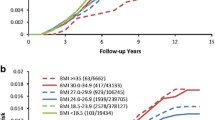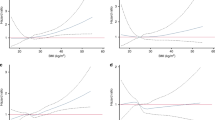Abstract
Purpose
The relationship between overall obesity and breast cancer risk has been well recognized, but the role of central obesity in breast cancer development is uncertain.
Methods
Between 1998 and 2009, 1,233 invasive breast cancer cases and 1,101 community controls were recruited into the Nigerian Breast Cancer Study at Ibadan, Nigeria. Logistic regressions were used to calculate multivariate odds ratio (OR) and 95% confidence intervals (CI), adjusting for age, body mass index (BMI), and other known risk factors for breast cancer.
Results
The OR for the highest quartile group of waist circumference relative to the lowest was 2.39 (95% CI, 1.59–3.60; P-trend <0.001). Comparing women with waist/hip ratio (WHR) in the lowest quartile group, the OR for women in the highest quartile category was 2.15 (95% CI, 1.61–2.85; P-trend <0.001). An inverse association was observed between hip circumference and breast cancer, with an OR of 0.36 for the highest quartile (95% CI, 0.24–0.55; P-trend <0.001). The effects of these three measures existed in both pre- and postmenopausal women. Of note, we found a significant interaction between WHR and BMI (P-interaction = 0.016): the OR comparing the highest to the lowest WHR quartile was 2.81 (95% CI, 1.90–4.16) for women with BMI < 25 kg/m2 and 1.70 (95% CI, 1.11–2.61) for women with BMI ≥ 25 kg/m2.
Conclusions
These results suggest that central adiposity, measured by waist circumference and waist/hip ratio, was an important risk factor for breast cancer in Nigerian women, and the effect of central adiposity was strong in normal-weight women.
Similar content being viewed by others
References
Ries L, Melbert D, Krapcho M et al (2008) SEER Cancer Statistics Review, 1975–2005. National Cancer Institute, Bethesda
Parkin DM, Whelan SL, Ferlay J et al. (2005) Cancer Incidence in Five Continents, vol I to VIII. IARC CancerBase No. 7, Lyon
Adebamowo CA, Adekunle OO (1999) Case-controlled study of the epidemiological risk factors for breast cancer in Nigeria. Br J Surg 86(5):665–668
Adebamowo CA, Ajayi OO (2000) Breast cancer in Nigeria. West Afr J Med 19(3):179–191
Jemal A, Ward E, Thun MJ (2007) Recent trends in breast cancer incidence rates by age and tumor characteristics among U.S. women. Breast Cancer Res 9(3):R28
Parkin DM, Sitas F, Chirenje M et al (2008) Part I: cancer in indigenous Africans–burden, distribution, and trends. Lancet Oncol 9(7):683–692
Huang Z, Willett WC, Colditz GA et al (1999) Waist circumference, waist:hip ratio, and risk of breast cancer in the Nurses’ health study. Am J Epidemiol 150(12):1316–1324
Muti P, Stanulla M, Micheli A et al (2000) Markers of insulin resistance and sex steroid hormone activity in relation to breast cancer risk: a prospective analysis of abdominal adiposity, sebum production, and hirsutism (Italy). Cancer Causes Control 11(8):721–730
Sonnenschein E, Toniolo P, Terry MB et al (1999) Body fat distribution and obesity in pre- and postmenopausal breast cancer. Int J Epidemiol 28(6):1026–1031
Mannisto S, Pietinen P, Pyy M et al (1996) Body-size indicators and risk of breast cancer according to menopause and estrogen-receptor status. Int J Cancer 68(1):8–13
Ng EH, Gao F, Ji CY et al (1997) Risk factors for breast carcinoma in Singaporean Chinese women: the role of central obesity. Cancer 80(4):725–731
Wu AH, Yu MC, Tseng CC et al (2007) Body size, hormone therapy and risk of breast cancer in Asian-American women. Int J Cancer 120(4):844–852
Kaaks R, Van Noord PA, Den Tonkelaar I et al (1998) Breast-cancer incidence in relation to height, weight and body-fat distribution in the Dutch “DOM” cohort. Int J Cancer 76(5):647–651
Lahmann PH, Hoffmann K, Allen N et al (2004) Body size and breast cancer risk: findings from the European prospective investigation into cancer and nutrition (EPIC). Int J Cancer 111(5):762–771
Harris HR, Willett WC, Terry KL et al (2011) Body fat distribution and risk of premenopausal breast cancer in the Nurses’ health study II. J Natl Cancer Inst 103(3):273–278
Nemesure B, Wu SY, Hennis A et al (2009) Body size and breast cancer in a black population–the Barbados national cancer study. Cancer Causes Control 20(3):387–394
Palmer JR, Adams-Campbell LL, Boggs DA et al (2007) A prospective study of body size and breast cancer in black women. Cancer Epidemiol Biomarkers Prev 16(9):1795–1802
Folsom AR, Kushi LH, Anderson KE et al (2000) Associations of general and abdominal obesity with multiple health outcomes in older women: the Iowa women’s health study. Arch Intern Med 160(14):2117–2128
Fagherazzi G, Chabbert-Buffet N, Fabre A et al. (2011) Hip circumference is associated with the risk of premenopausal ER-/PR- breast cancer. Int J Obes (Lond). doi:10.1038/ijo.2011.66
Morimoto LM, White E, Chen Z et al (2002) Obesity, body size, and risk of postmenopausal breast cancer: the women’s health initiative (United States). Cancer Causes Control 13(8):741–751
den Tonkelaar I, Seidell JC, Collette HJ et al (1992) Obesity and subcutaneous fat patterning in relation to breast cancer in postmenopausal women participating in the diagnostic investigation of mammary cancer project. Cancer 69(11):2663–2667
Petrek JA, Peters M, Cirrincione C et al (1993) Is body fat topography a risk factor for breast cancer? Ann Intern Med 118(5):356–362
Cooper R, Rotimi C, Ataman S et al (1997) The prevalence of hypertension in seven populations of west African origin. Am J Public Health 87(2):160–168
Senbanjo IO (2007) Overweight and obesity in Nigerian preschool children. J Trop Pediatr 53(2):143–144
Ogunjimi L, Ikorok M, Yusuf O (2010) Prevalence of obesity among Nigeria nurses: the Akwa Ibom State experience. Intern NGO J 5(2):45–49
Perry AC, Applegate EB, Jackson ML et al (2000) Racial differences in visceral adipose tissue but not anthropometric markers of health-related variables. J Appl Physiol 89(2):636–643
Katzmarzyk PT, Bray GA, Greenway FL et al (2010) Racial differences in abdominal depot-specific adiposity in white and African American adults. Am J Clin Nutr 91(1):7–15
Deurenberg-Yap M, Chew SK, Deurenberg P (2002) Elevated body fat percentage and cardiovascular risks at low body mass index levels among Singaporean Chinese, Malays and Indians. Obes Rev 3(3):209–215
Adebamowo CA, Ogundiran TO, Adenipekun AA et al (2003) Waist-hip ratio and breast cancer risk in urbanized Nigerian women. Breast Cancer Res 5(2):R18–R24
Huo D, Adebamowo CA, Ogundiran TO et al (2008) Parity and breastfeeding are protective against breast cancer in Nigerian women. Br J Cancer 98(5):992–996
WHO (1998–1999) WHO MONICA Project. MONICA Manual. http://www.ktl.fi/publications/monica/manual/index.htm
van Buuren S, Boshuizen HC, Knook DL (1999) Multiple imputation of missing blood pressure covariates in survival analysis. Stat Med 18(6):681–694
Rubin DB (1987) Multiple Imputation for Nonresponse in Surveys, 1st edn. John Wiley, New York
Royston P (2004) Multiple imputation of missing values. Stata J 4(3):227–241
Ogundiran TO, Huo D, Adenipekun A et al (2010) Case-control study of body size and breast cancer risk in Nigerian women. Am J Epidemiol 172(6):682–690
Okobia MN, Bunker CH, Zmuda JM et al (2006) Anthropometry and breast cancer risk in Nigerian women. Breast J 12(5):462–466
Hall IJ, Newman B, Millikan RC et al (2000) Body size and breast cancer risk in black women and white women: the Carolina breast cancer study. Am J Epidemiol 151(8):754–764
John EM, Sangaramoorthy M, Phipps AI et al (2010) Adult body size, hormone receptor status, and premenopausal breast cancer risk in a multiethnic population: the San Francisco bay area breast cancer study. Am J Epidemiol 173(2):201–216
Nemesure B, Wu SY, Hambleton IR et al (2009) Risk factors for breast cancer in a black population–the Barbados national cancer study. Int J Cancer 124(1):174–179
Shu XO, Jin F, Dai Q et al (2001) Association of body size and fat distribution with risk of breast cancer among Chinese women. Int J Cancer 94(3):449–455
Lovegrove JA (2002) Obesity, body fat distribution and breast cancer. Nutr Res Rev 15(2):389–412
Kissebah AH, Krakower GR (1994) Regional adiposity and morbidity. Physiol Rev 74(4):761–811
Xue F, Michels KB (2007) Diabetes, metabolic syndrome, and breast cancer: a review of the current evidence. Am J Clin Nutr 86(3):S823–S835
Bruning PF, Bonfrer JM, Hart AA et al (1992) Body measurements, estrogen availability and the risk of human breast cancer: a case-control study. Int J Cancer 51(1):14–19
Kirschner MA, Samojlik E, Drejka M et al (1990) Androgen-estrogen metabolism in women with upper body versus lower body obesity. J Clin Endocrinol Metab 70(2):473–479
Haffner SM, Katz MS, Stern MP et al (1989) Relationship of sex hormone binding globulin to overall adiposity and body fat distribution in a biethnic population. Int J Obes 13(1):1–9
Subbaramaiah K, Howe LR, Bhardwaj P et al (2011) Obesity is associated with inflammation and elevated aromatase expression in the mouse mammary gland. Cancer Prev Res 4(3):329–346
Parker ED, Pereira MA, Stevens J et al (2009) Association of hip circumference with incident diabetes and coronary heart disease: the Atherosclerosis risk in communities study. Am J Epidemiol 169(7):837–847
Acknowledgments
The study was funded by the National Cancer Institute at the National Institutes of Health (CA-RO1 89085-01A and P50 CA125183) and the Dr. Ralph and Marian Falk Medical Research Trust. The authors thank the interviewers, data managers, and support staff at the University College Hospital Ibadan and the data managers at the University of Chicago for their diligent and professional work.
Conflict of interest
None declared.
Author information
Authors and Affiliations
Corresponding authors
Rights and permissions
About this article
Cite this article
Ogundiran, T.O., Huo, D., Adenipekun, A. et al. Body fat distribution and breast cancer risk: findings from the Nigerian breast cancer study. Cancer Causes Control 23, 565–574 (2012). https://doi.org/10.1007/s10552-012-9916-y
Received:
Accepted:
Published:
Issue Date:
DOI: https://doi.org/10.1007/s10552-012-9916-y




